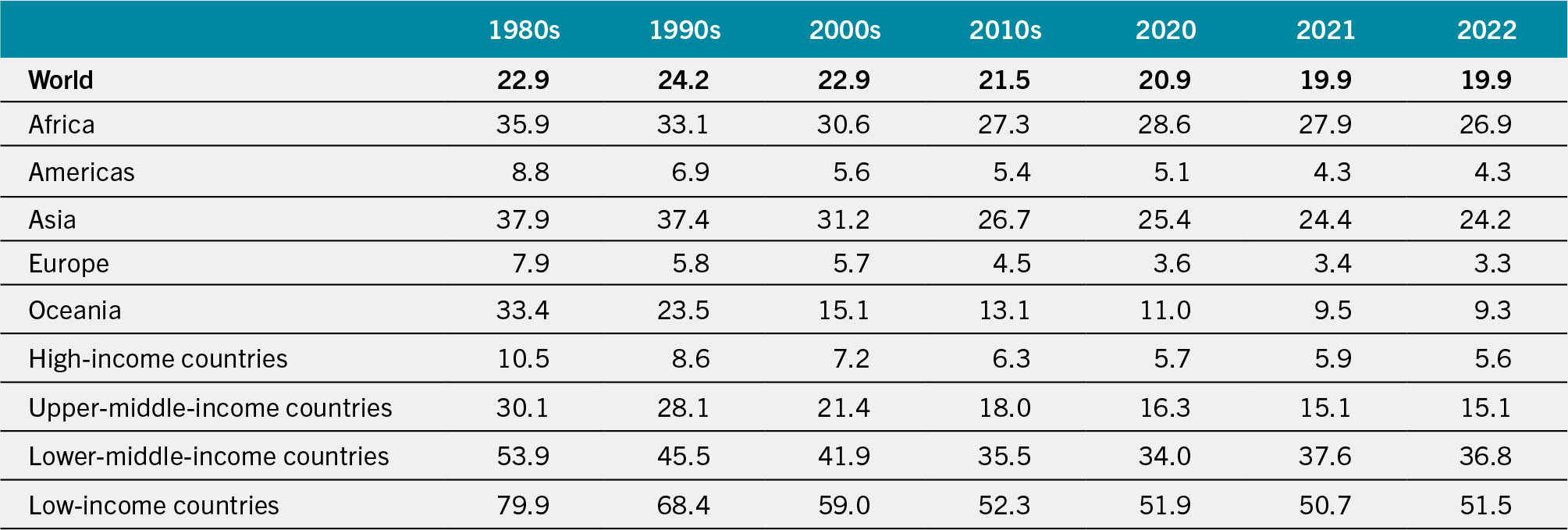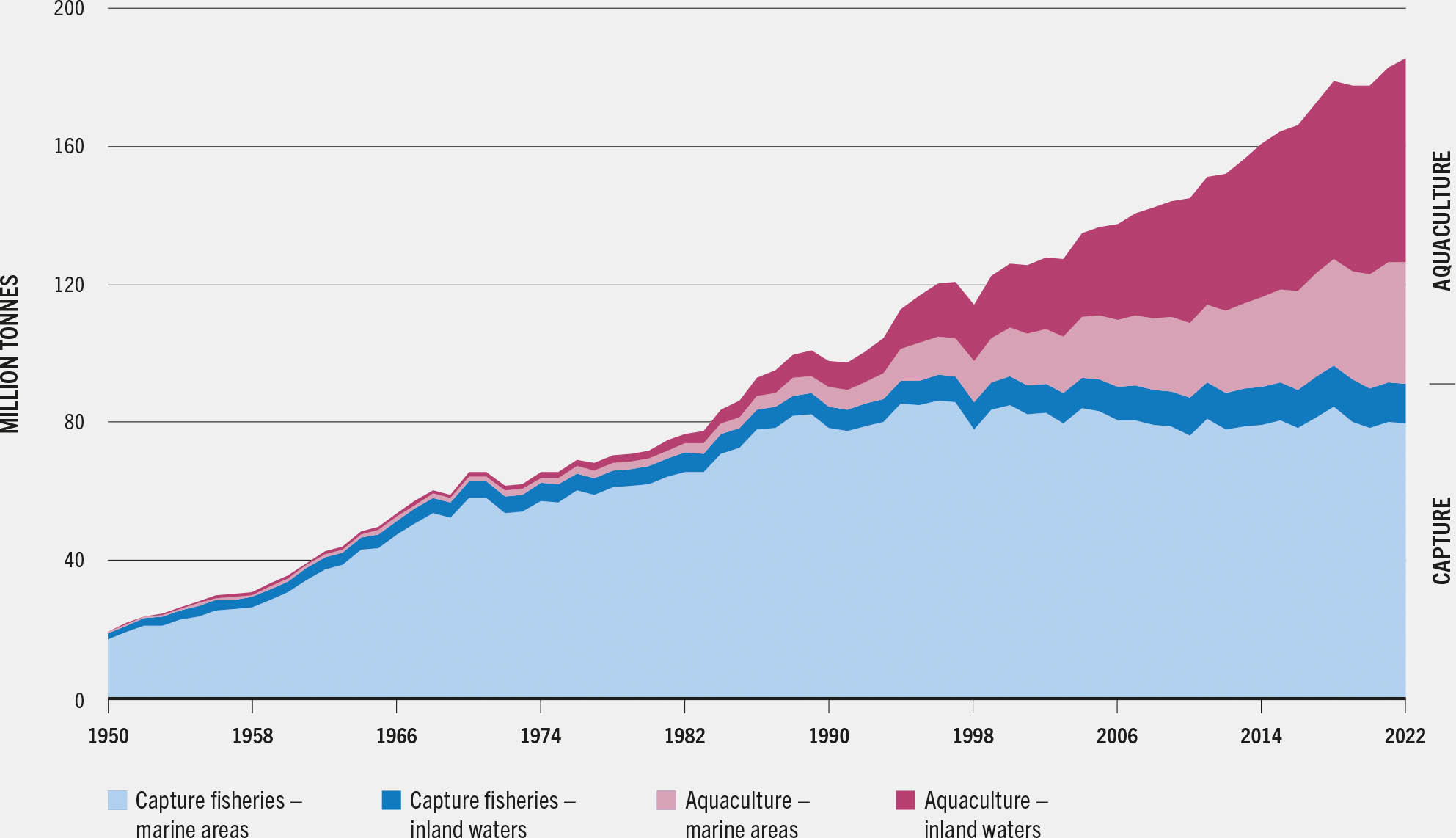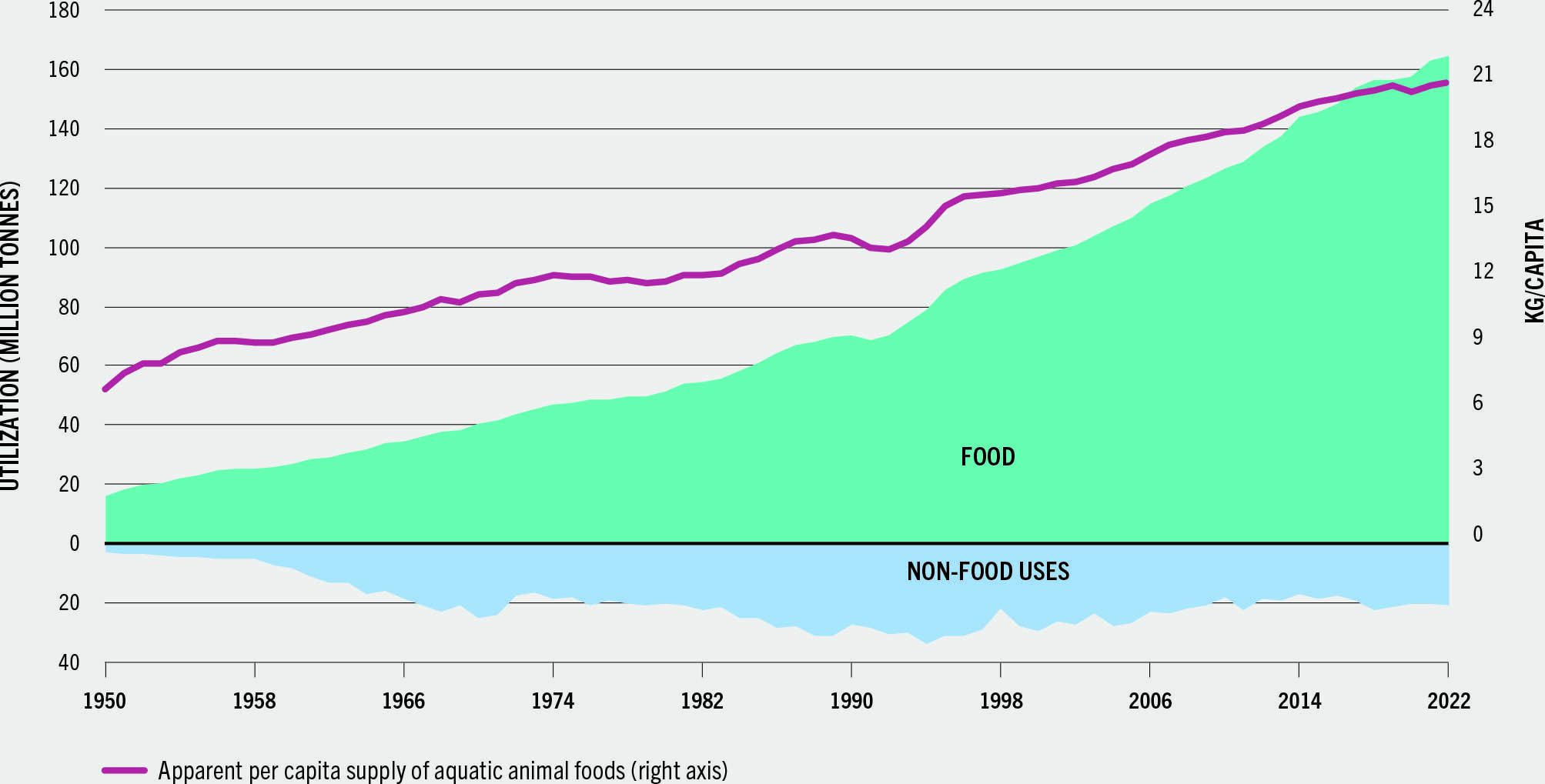Aquatic food systems are very diverse and offer a variety of environmental, economic and social benefits and services. They are increasingly recognized – at the global level and in many countries and communities – for their nutritional value and ecosystem services that contribute to sustaining healthy diets and aquatic biodiversity. More than ever before, they represent viable solutions and offer opportunities to improve global food security and nutrition, enhance livelihoods and preserve the environment.
Consolidation of the role of aquatic food systems requires the acceleration of transformative changes to achieve sustainable and equitable global fisheries and aquaculture. In 2021, FAO adopted Blue transformation as Programme Priority Area BP2,b aimed at maximizing the opportunities presented by aquatic food systems to enhance food security, improve nutrition, eradicate poverty and support the achievements of the 2030 Agenda for Sustainable Development. FAO developed the FAO Blue Transformation Roadmap to clarify concepts and offer guidance on its objectives and priority actions.c
The State of World Fisheries and Aquaculture 2024 presents the status of global fisheries and aquaculture, showcasing how, through “Blue Transformation in action”, FAO, in coordination with Members and partners, promotes collaborative efforts and implements initiatives to support sustainable aquaculture intensification and expansion, effective management of global fisheries, and upgrading of aquatic food value chains. Following improvements in data collection and advancements in analytical and assessment tools and methodologies (Box 1), the data on the state of world fisheries and aquaculture production and utilization have been revised and expanded.
BOX 1FISHERIES AND AQUACULTURE STATISTICS: CHALLENGES AND OPPORTUNITIES
The crucial role of data in evidence-based policymaking, monitoring and performance evaluation depends on their accessibility, reliability and relevance. Over the years, most countries have developed systems for collecting and analysing fisheries and aquaculture statistics. Unfortunately, coverage and frequency of data collection remain a challenge for many countries. Use of non-standardized processes, combined with weak capacity for data collection, storage, digitalization and analysis, results in fragmentation of collection and dispersion of data across different institutions with limited communication and coordination.
Specific challenges include the following:
- Fisher and vessel registries are absent in many countries, hampering quality of employment and fleet statistics.
- Small-scale, subsistence (FAO, 2023) and recreational fisheries, and illegal, unreported and unregulated fishing often go unaccounted for.
- Transshipment is hard to track at sea, as are landings in in foreign ports, hindering collection of catch data and trade statistics.
- National household or labour surveys often fail to cover the necessary fisheries and aquaculture information, resulting in poor quality data.
The result is insufficient evidence of the importance of fisheries and aquaculture and their vital contribution to national development. This can obscure the visibility of aquatic food systems leading to their marginalization in national, regional or global policy and decision-making processes addressing resource allocation and international development.
These issues were discussed in a series of meetings organized by FAO in 2022, involving about 500 people representing 120 national focal points for the provision of fisheries and aquaculture statistics to FAO. A key outcome was a call for the urgent development of a new global strategy for fisheries and aquaculture statistics.* In addition, the meetings highlighted the need to support the development of national statistical strategies, strengthen institutional and technical capacities, and improve statistical systems to better design, monitor and evaluate the effectiveness of policies, interventions and programmes. In this regard, FAO should enhance its work on improving and developing adapted methodologies and tools for the collection of different typologies of fisheries and aquaculture statistics, in collaboration with other international and regional organizations, also within the framework of the Coordinating Working Party on Fishery Statistics of which FAO is Secretariat. FAO works to mobilize the necessary resources for this ambitious, yet fundamental programme to enhance national, regional and global data collection schemes for fisheries and aquaculture.
FAO is mandated by its Members to regularly produce updated and reliable information by collecting and curating global statistics, studies and analyses and by disseminating this information through its channels to serve for evidence-based policymaking, monitoring and performance evaluation (Ababouch et al., 2016). FAO is the only source of global fisheries and aquaculture statistics (FAO, 2022); its FishStat database covers employment, fleet, production, utilization, trade and consumption, using primarily data collected annually from national sources. In the absence of national reporting, or in the event of insufficient or inconsistent data, FAO makes estimates based on the best data available from alternative authoritative sources using approved methodologies. These estimates enable meaningful aggregates at the global, regional and national levels. Overall, in 2022, the share of estimated data was 16 percent for production, 6 percent (compared to the usual 2 percent) for trade, 48 percent for employment and 44 percent for fleet. While these percentages may vary from year to year, data collection on employment and fishing vessels presents a major challenge for many countries.
The FishStat data collected and disseminated by FAO since 1950 reflect the evolution of fisheries and aquaculture statistics collection, with significant variations in the quality of the data received. The granularity of the data – for example, the level of detail by species – is critical for monitoring the exploitation of fishery resources and their economics along value chains. On the one hand, the granularity of the FAO production statistics has improved significantly – from 660 species items in the early 1950s to about 3 600 species items in 2022 (with approximately 3 400 items for the capture fisheries dataset and 730 for aquaculture); on the other, a significant share of production – 20 percent in 2022 (compared with 24 percent in the 1990s) – is still not reported at species level, but in broader groups, at family or higher taxonomic levels. The table shows that data reported under broader groups accounted for 6 percent of the total production in high-income countries in 2022, compared with 52 percent in low-income countries. The revised FAO Fishery and Aquaculture Statistics Yearbook** presents in tables T.8 and T.9 a detailed analysis of the evolution of these trends. Similar trends are encountered in trade statistics: granularity has improved over time (from about 32 percent of trade data reported by major species group in the 1970s to about 15 percent in 2022), but there is still much room for improvement.
SHARE OF FISHERIES AND AQUACULTURE PRODUCTION REPORTED UNDER GENERIC ITEMS AT FAMILY OR HIGHER TAXONOMIC LEVEL

** Available at: https://www.fao.org/fishery/en/statistics/yearbook
SOURCES: Ababouch, L., Taconet, M., Plummer, J., Garibaldi, L. & Vannuccini, S. 2016. Bridging the Science–Policy Divide to Promote Fisheries Knowledge for All: The Case of the Food and Agriculture Organization of the United Nations. In: Bertrum, H., MacDonald, B.H., Soomai, S.S., De Santo, E.M. & Wells, P.G., eds. Science, Information, and Policy Interface for Effective Coastal and Ocean Management. Boca Raton, USA, CRC Press. https://doi.org/10.1201/b21483 FAO. 2003. Strategy for Improving Information on Status and Trends of Capture Fisheries. Stratégie visant à améliorer l’information sur la situation et les tendances des pêches de capture. Estrategia para mejorar la información sobre la situación y las tendencias de la pesca de capyura. Rome/Roma, FAO. https://www.fao.org/fishery/en/publication/11495?lang=en FAO. 2022. The State of World Fisheries and Aquaculture 2022. Towards Blue Transformation. Rome. https://doi.org/10.4060/CD0683EN
In 2022, the global production of aquatic animals reached a new world high of 185 million tonnes (live weight equivalent), an increase of 4 percent from 2020. Farming of aquatic animals produced an estimated 94 million tonnes, representing 51 percent of the total, surpassing for the first time capture fisheries, which produced 91 million tonnes (49 percent). Production from marine areas was 115 million tonnes (62 percent of the total), of which 69 percent was from capture fisheries and 31 percent from aquaculture. Inland waters contributed 70 million tonnes (38 percent of the total), of which 84 percent was from aquaculture and 16 percent from capture fisheries (Table 1 and Figure 1). The world fishing fleet continued to decrease from the 2019 peak of 5.3 million vessels to an estimated 4.9 million vessels in 2022, of which two-thirds were motorized.
TABLE 1WORLD FISHERIES AND AQUACULTURE TRENDS AT A GLANCE

* Utilization data for 2020–2022 are provisional estimates. These data might differ from the apparent consumption data as they do not take into account trade.
** Exports including re-exports. Share of trade in total production calculated excluding re-exports. Trade data do not include frogs and turtles.
*** Employment refers to the number of people engaged in the primary sector only. Figures for the 1990s are based on 1995–1999 data.
**** Fishing fleet figures for the 1990s are based on 1995–1999 data.
SOURCES: For production: FAO. 2024. FishStat: Global production by production source 1950–2022. [Accessed on 29 March 2024]. In: FishStatJ. Available at: www.fao.org/fishery/en/statistics/software/fishstatj. Licence: CC-BY-4.0.
For trade: Preliminary data. Final data available here: FAO. 2024. Global aquatic trade statistics. https://www.fao.org/fishery/en/collection/global_commodity_prod. Licence: CC-BY-4.0.
For employment: Preliminary data. Final data available here: FAO. (forthcoming). Fishery and Aquaculture Statistics – Yearbook 2022. FAO Yearbook of Fishery and Aquaculture Statistics. Rome. https://www.fao.org/fishery/en/statistics/yearbook
Population data used to calculate apparent consumption per capita are based on United Nations Population Division. 2022. World Population Prospects 2022. [Accessed 13 January 2023]. https://population.un.org/wpp
FIGURE 1WORLD FISHERIES AND AQUACULTURE PRODUCTION OF AQUATIC ANIMALS

SOURCE: FAO. 2024. FishStat: Global production by production source 1950–2022. [Accessed on 29 March 2024]. In: FishStatJ. Available at: www.fao.org/fishery/en/statistics/software/fishstatj. Licence: CC-BY-4.0.
The first sale value of the 2022 global production of aquatic animals was estimated at USD 452 billion, comprising USD 157 billion for capture fisheries and USD 296 billion for aquaculture. Of the total 185 million tonnes of aquatic animals produced in 2022 (Figure 2), about 164.6 million tonnes (89 percent) were destined for human consumption, equivalent to an estimated 20.7 kg per capita. The remaining 20.8 million tonnes were destined for non-food uses, to produce mainly fishmeal and fish oil (17 million tonnes or 83 percent). Aquaculture consolidated its contribution to food for human consumption, supplying over 57 percent of aquatic animal foods (live weight equivalent) in 2022.
FIGURE 2UTILIZATION OF WORLD FISHERIES AND AQUACULTURE PRODUCTION OF AQUATIC ANIMALS

SOURCES: Preliminary data. Final data available here: FAO. (forthcoming). Fishery and Aquaculture Statistics – Yearbook 2022. FAO Yearbook of Fishery and Aquaculture Statistics. Rome. https://www.fao.org/fishery/en/statistics/yearbook
Population data are based on United Nations Population Division. 2022. World Population Prospects 2022. [Accessed on 13 January 2023]. https://population.un.org/wpp
Over the decades, global apparent consumption of aquatic animal foods has increased significantly, at a higher annual growth rate than the world population. Between 1961 and 2021, apparent consumption of aquatic animal foods increased at an average annual rate of 3.0 percent compared with a world population annual growth rate of 1.6 percent for the same period. Per capita apparent consumption of aquatic animal foods grew on average by 1.4 percent per year, from 9.1 kg (live weight equivalent) in 1961 to 20.6 kg in 2021. The main drivers of the continuous growth in per capita consumption are increased supplies, advancements in preservation and distribution technology, changing consumer preferences, and income growth.
Following a decrease of 6.7 percent in the value of trade of aquatic animal products experienced in 2020 because of the COVID-19 pandemic, there was a rapid recovery starting in late 2020. It was driven by a robust recovery in global supply and demand and increasing commodity prices. This caused a significant rebound in 2021 and 2022, with trade of aquatic animal products in 2022 increasing by 19 percent compared with the pre-pandemic levels of 2019. Seventy million tonnes (live weight equivalent) of aquatic animal products (38 percent of the total production), worth USD 192 billion (Table 1), were exported worldwide in 2022, representing more than 9.1 percent of total agricultural trade (excluding forest products) and about 1 percent of total merchandise trade in value terms in 2022. This represents a new world high, surpassing the 2018 record of USD 165 billion.
From a value of USD 7.9 billion in 1976, trade of aquatic animal products has experienced an average annual growth rate of 7.2 percent in nominal terms and 4.0 percent in real terms (adjusted for inflation). Exports of algae contributed an additional USD 1.6 billion and exports of other aquatic products such as sponges, corals, shells and inedible by-products added an extra USD 0.9 billion in 2022. The total export value of all aquatic products reached a record high of USD 195 billion in 2022.
Fisheries and aquaculture generate significant employment and support livelihoods in many coastal communities. In 2022, about 62 million people were engaged in the primary sector of fisheries and aquaculture as full-time, part-time, occasional or unspecified workers. About 54 percent of this workforce was engaged in fisheries and 36 percent in aquaculture, while the remaining 10 percent could not be broken down between fisheries and aquaculture. A significant proportion of this workforce was engaged in artisanal and small-scale operations.



